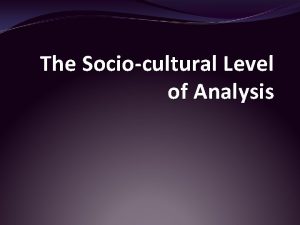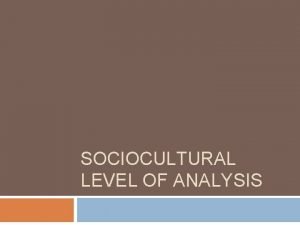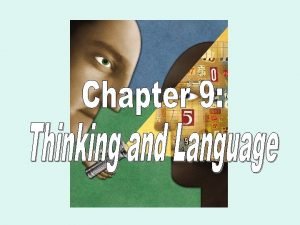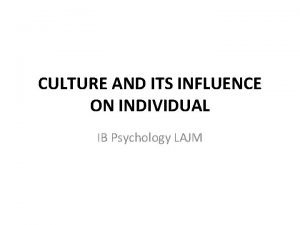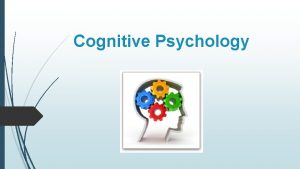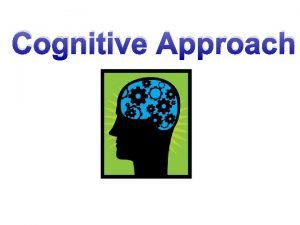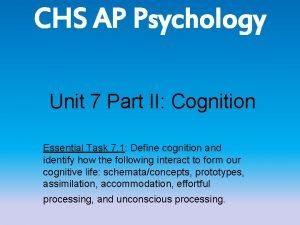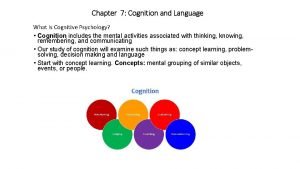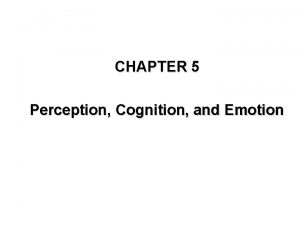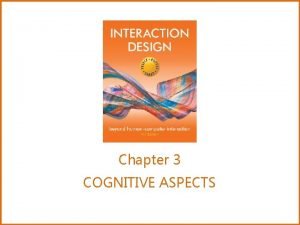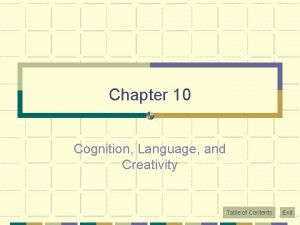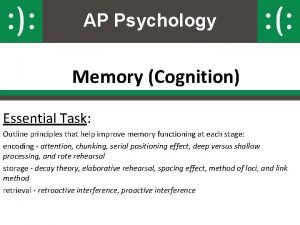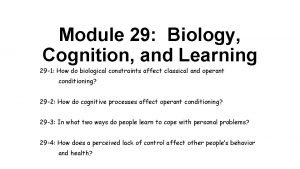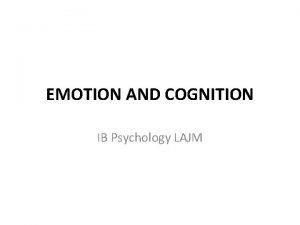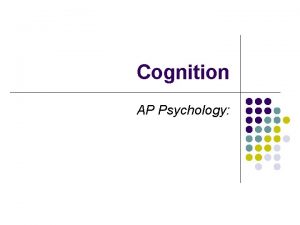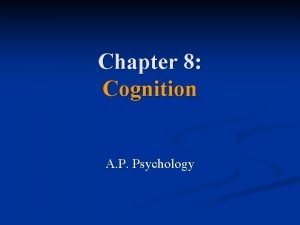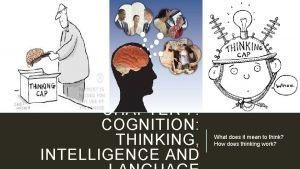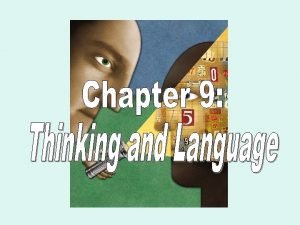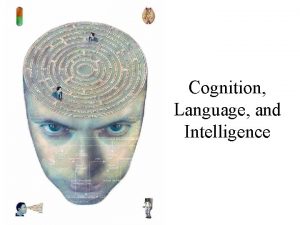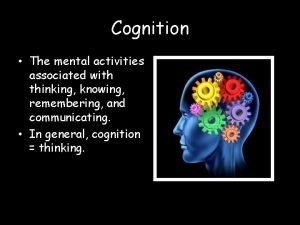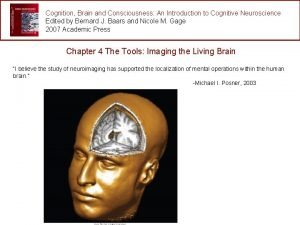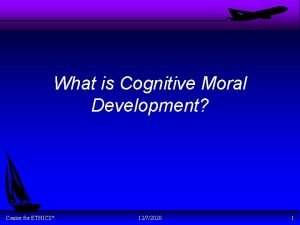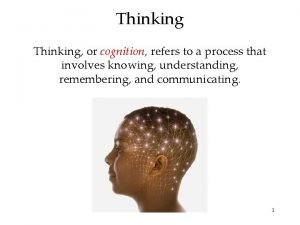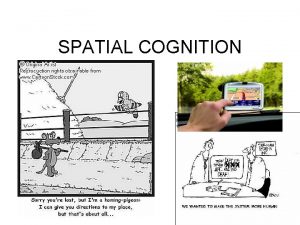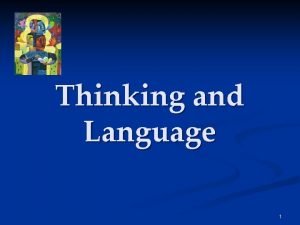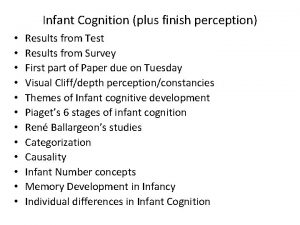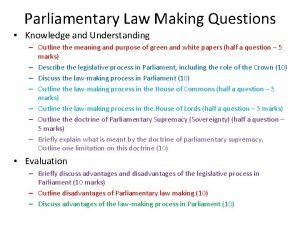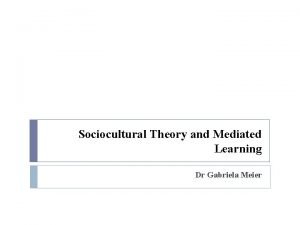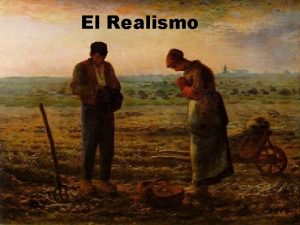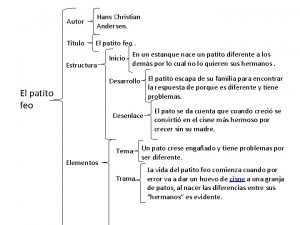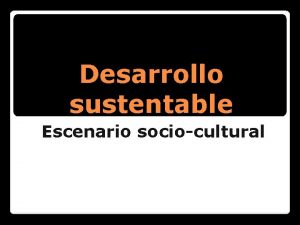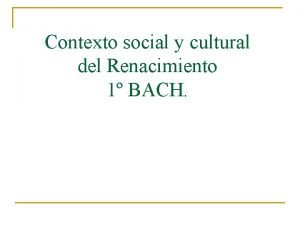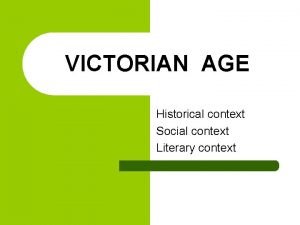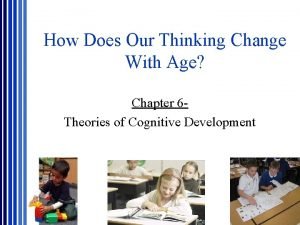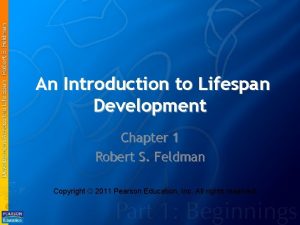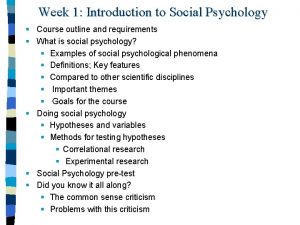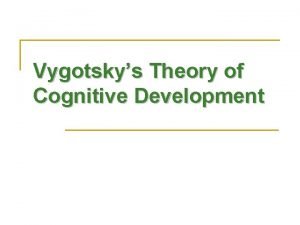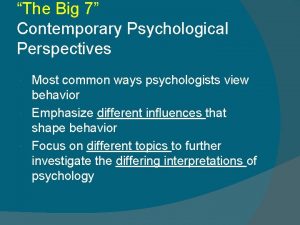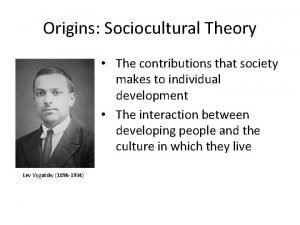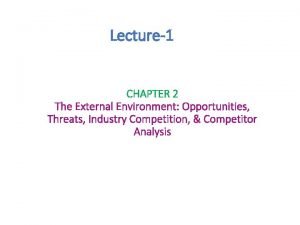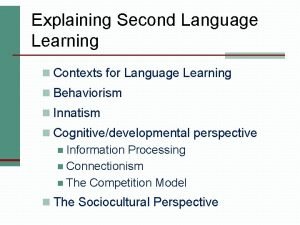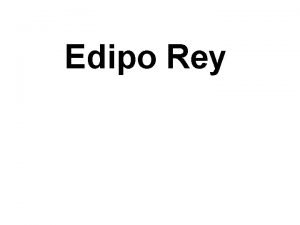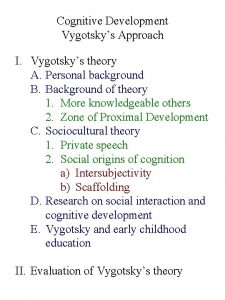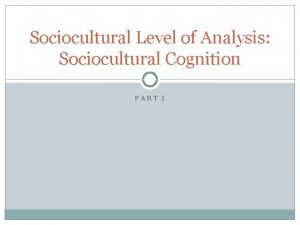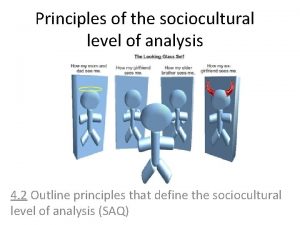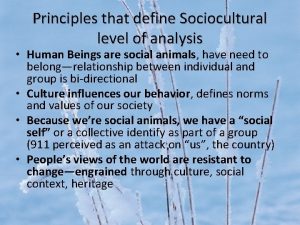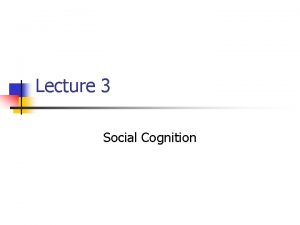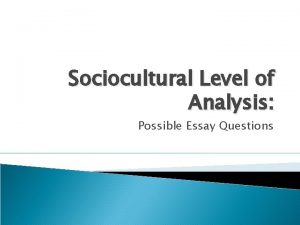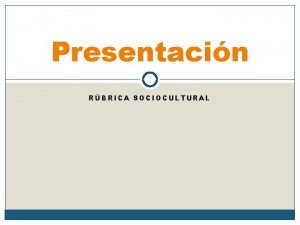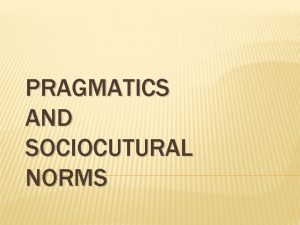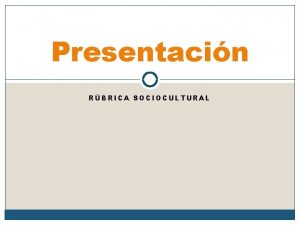Sociocultural level of analysis Sociocultural cognition Outline principles















































































- Slides: 79

Sociocultural level of analysis: Sociocultural cognition

Outline principles that define the sociocultural level of analysis - for example: As human beings we are constantly being influenced by other people, and by the requirements of society, even when we believe we are acting independently; Human behavior is explained by the social situation more than dispositional factors, such as individual personality; We are social animals and require others for our survival

4 Principles that define sociocultural levels of analysis 1. Human Beings are social animals 2. Culture influences behavior. 3. Humans have a social self 4. Peoples views of the world are resistant to change

Human Beings are social animals Human behavior is explained by the social situation more than dispositional factors, such as individual personality; We are social animals and require others for our survival. We have the need to belong Note group relationship: group effect ↔ individual effect

Example: Humans are Social Animals Howarth (2002) focus group with adolescent girls in Brixton. Aim: to study how the girls described and evaluated themselves. Method: focus Group Results: girls had a positive view of “being from Brixton” which contrast to view of people living outside Brixton. Conclusion: This can be seen as creating a positive “social identity” based on belonging to a group.

Culture influences behavior Culture = the norms and values defined by a society.

Berry (1967) Aim: how does conformity relate to culture Method: experimental (version of the Asch experiment ) Temne people (agricultural) – rely on cooperarion. Inuits (hunters & fishers) must be able to track and hunt on their own. Results: Inuits were almost non-conforming whereas the Temne were mostly conforming Example: Culture influenced Behavior

Humans have a social self The social self is said to be a collective or social identity. Example: when Princess Diana died people mourned as if she were a member of their family. When the US Hockey Team won the gold, the connections was so strong, you would have thought each of us had a brother playing in the team!

Peoples views of the world are resistant to change World View: The way the world is understood How is it suppose to work Why it works the way it does What values are essential to the community


Explain how principles that define the sociocultural level of analysis may me demonstrated in research Research Methods at the Sociocultural levels of analysis Pg. 102 -103

How do people interact with each other? Research: Qualitative in nature Naturalistic – research is done in the environments in which the behavior is most likely to take place. Methods: Observations Interviews Focus groups

Discuss how and why particular research methods are used at the sociocultural levels of analysis

Qualitative Research Cont. , Why choose qualitative research for sociocultural study? Ecological Validity Environment is more realistic to the behavior What kind of data is gathered? Descriptive data Does not show cause and effect How does this differ from Lab Experiments?

Participant Observation Participant observation attempts to view the world through the eyes of the individual being studied. Two types of observation techniques Overt Require researcher to gain trust O’Reilly (2000) study of British expatriates on the island of Costa del Sol. Covert Used to infiltrate groups that would not normally permit observation. Researcher must gain trust – Done through deceit. No informed consent Relies on memory, thus data is open to distortion. NO interviews can be carried out!!!!!

Covert Research Leon Festinger et al’s. When Prophecy Fails (1956) Religious cult that believed the world was going to end on Dec. 21. When the catastrophe occurred they would be rescued by a flying saucer as long as they followed the prescribed rituals and read the sacred text. Festinger and his team became members of the cult. Monitored the group members doubt. Debate and rationalization of what had taken place. The group decided that God had not destroyed the world because of their prayers.

Discuss Ethical Considerations related to research studies at the SCOA

Ethics Overt vs covert (Festinger, 1956) Use of Deception (Berry, Ach, Festinger) Harm to individual (Zombardo, Milgram)

Be a thinker If you were a reporter covering the study, what questions would you ask Festinger and his team? Discuss the ethical concerns you would have with this research.

Describe the role of situational and dispositional factors in explaining behavior. pgs 103 - 106

Fritz Heider (1958) Attribution Theory Attribution is theory is based on the assumption that people: Tend to look for cause and reason for others behavior because they feel that there are motives behind most of their own behavior. Are intuitive psychologist who construct their own causal theories of human behavior. Construct causal theories because they want to understand, predict, and control the environment around them.

Attribution Theory Fritz Heider (1958), The Psychology of Interpersonal Relationships Actor-observer effect Attribution about behavior based on whether they are performing or observing. Situational factor External factors associated with individual discussed their own behavior. Dispositional factor Internal factors associated when an individual discusses someone else's’ behavior. Attribution Theory Video (9: 41)

Discuss two errors in attribution.

3 Errors in Attribution 1. Fundamental error attribution error 2. Self-serving bias (SSB) 3. Modesty bias

Errors in Attribition Fundamental attribution error: (3: 55) When individual overestimate dispositional factors in someone's behavior and underestimates situational factors. Example: the public tends to describe actors based upon the roles (dispositional) that they have been casted (situation – auditioned for). What may cause this behavior? Not enough information to create a balance decision, thus individual attribute behavior based upon disposition. When assessing themselves, individuals tend to take into consideration the situation or circumstances.

Fundamental attribution error: Ross et al. (1977) Aim: would students make the fundamental attribution error knowing that all the actors were simply playing a role? Method: experimental Procedure: Randomly placed in groups Game show host Designed their own questions Contestants Members of the audience Asked to rank the intelligence all invovlved

Fundamental attribution error: Ross et al. (1977) Result: they consistently ranked the game show host the most intelligent. Conclusion: People overlook situational factors when assessing attributes CONCERNS: Made up of students – may perceive the question make with higher authority. Not a representation of the general population

Strengths and limitation FAE The theory has promoted understanding of common errors in explanation of what happens in the world. The theory has proven very robust and has been supported by many research studies The theory is culturally biased with too much focus on individualism. Much research has been conducted in laboratories and with student samples.

Self Serving Bias (SSB) Self serving bias (3: 25) one attributes success to disposition factors, and dissociate themselves from their failures attributing them to situational factors. Lau and Russel (1980) American football coaches and players attribute their wins to internal factors (being in good shape, talent) - and their failures to external factors (weather, injuries, fouls committed by the other team)

Cultural difference in SSB Kashima and Triandis (1986) U. S. and Japanese students Procedure: remember details of slides of scenes from unfamiliar countries When asked to explain their success, American attributed to their ability, while Japanese tended explain their failures in terms of lack of ability. This is termed modesty bias Conclusion: because of the more collective nature of many Asian societies, people derive their self esteem not from individual accomplishments but from group identity. (less likely to use SSB)

Strengths and Limitations SSB The theory can explain why some people explain their failures as being caused by situation The theory is culturally biased. It cannot explain why some cultures emphasize a self-effacing attribution (modesty bias).

Evaluate social identity theory. Pages 106 – 108 Social Identity 4: 22

Henri Taj. Fel’s Social Identity Theory Individuals strive to improve their self image by trying to enhance their self-esteem, based on: personal identity Personal achievement or various social identities Affiliation with a successful group. Cognitive Process = Social Categorizing

In-group (us) vs. out-group (them) In-group favoritism: When an individual gets selfesteem from being a member of a group and sees his/her group as superior to others. Actions taken tend to benefit the group. Level of self esteem is maintained by Social Comparison Cialdini et al. , (1976) after a successful football match college supporters were more likely to be wearing logo/insignia than after the team lost a game. Tajfel “the establishment of positive distinctiveness”

In-group (us) vs. out-group (them) Out-group homogeneity: A result of social categorization, this is when all members of the outgroup are seen to have the same characteristics. They are all cheaters or rich or snobby or fashion unaware.

Tajfel et al. (1971) Kandinsky vs. Klee experiment

Boys were randomly assigned groups based supposedly on their preference in art were more likely to identify with the boys in their group and were willing to give higher awards to members of their group. The out-group was ranked as less likable, but was never actually disliked. Conclusion: group identity alone does not account for intergroup conflict. In the absence of competition, social comparison does not necessarily produce negative outcome.

Social Identity Learning Theory Downward comparison: In a study by Taylor, Wood & Lichtman (1983), they found that breast cancer patients who engaged in downward comparison (comparing themselves to someone worse off than themselves) had better recovery times and more positive self-esteem; those who engage in upward comparison (comparing themselves to someone better off than themselves) tended to have longer recovery times and were more likely to suffer from depression.

Strengths and limitation of social identity theory Good way of understanding human behavior, i. e. ethnocentrism, favoritism, conformity, serotyping. Assumes intergroup conflict is not required for discrimination to occur (Tajfel, 1970) Established + of in-group by establishing the – of the out-group. Describes, but does not accurately predict human behavior. Why is our personal identity stronger than our group identity at times? It fails to take into account the environment Cultural expectations Rewards Social constraints (poverty)

Social Representations Moscovici (1973) – group theory Social Representations – shared beliefs and explanations held by the society in which we live. Social Representations create the foundation for Social Cognition Cultural Schemas that are fundamental to identity of the group Howarth (2002) Brixton focus group study

In –group/out-group How effective are these group based activities? Why or Why not? Fall Fling/Spring Fling? Pep-rallies Group therapy

Homework Read 108 -110 Find 2 examples of stereotypes in the media (newspaper, magazines, books, packaging, products, posters or films). Bring the image to class, and explain why the image represents a stereotype and why you think this image persists.

Explain the formation of stereotypes and their effect on behavior Pg 108 -110

Stereotyping Stereotype – a social perception of an individual in terms of group membership or physical attributions. Positive/negative A form of social categorizing that affects the behavior of those who hold the stereotype and those that are labelled. A form of schema processing.

Stereotype threat: the effect of the stereotypes on an individuals performance Steele and Aronson (1995) Aim: to determine the affects stereotype has on performance Method: lab experiment Procedure: Minority Group and European American Group. When both were told it was a test for ability, the minority group did poorly. When both were told it was a ‘lab test to study how certain problems were solved’ the performance were not significantly different. Conclution: Stereotype threat can affect the members of just bout any social or cultural groups, if the members believe in the stereotype.

Spotlight Anxiety Steele (1997) argurs, stereotype threat triggers spotlight anxiety, Emotional distress and pressure that may undermine performance Spencer et al. , (1977) Assessed mathematical performance and literary performance of men and women (both of which were highly skilled in both areas). Women scored high on literary but not in the math. Spencer attributes this to stereotype threat and spotlight anxiety.

What do you think? In 1994, a controversial book, The Bell Curve (by Richard J. Hernstein) was published, discussing the IQs of different ethnic groups. One stereotype it perpetuated was that all Asians are very intelligent. In spite of this being a rather “positive” stereotype, how could this also be an example of stereotype threat? What are the negative effects of such stereotype?

Formation of stereotypes Social categorization: The cognitive process of allocating people to groups - either as an "in-group" to which one belongs, or an "out-group. . " This process helps us to describe and predict the world more efficiently. Social comparison: Individuals evaluate their own opinions and abilities by comparing themselves to others in order to reduce uncertainty in these domains, and learn how to define the self. It is a way to build self-esteem and a way to resolve ambiguity

How Stereotypes Develop Campbell (1967): There are two key sources to stereotypes Personal experience Individuals and groups Gatekeepers (media, parents other members of culture) Grain of Truth hypothesis: an experience with an individual from a group will then be generalized to the whole group.

Illusory correlation Hamilton and Gifford (1976) : Illusory correlation People see a relationship between two variable even when there is none. Gender and culturally based prejudice about social groups Illusory correlation is an example of cognitive bias. *Attribution errors are also examples of cognitive bias. Once Illusory correlations are made, individuals will seek information to remember/support = conformational bias

Conformational Bias: People seek information to support their bias Overlook information that contradicts the belief Results in rigidity – resistance to change. Research on stereotype prejudice is very difficult due to social desirability effect.


Key evaluation strategies Many of the early studies lacked ecological validity, but there are many studies that have been done in a naturalistic environment. The theory does not look at dispositional factors. Some people may be more competitive. The theory does not look at cultural factors. Collectivistic societies tend to be less consistent in this behavior. Has high heuristic validity – that is, it can be used to explain a lot of things.

Key evaluation strategies cont. , Overly theoretical and difficult to refute. For example, Bem’s theory of sexuality. Cannot predict when someone’s individual identify will supercede that of the group. Why does some out-group discrimination lead to violence? Sherif said it was about limited resources. Is this a valid claim? Environmental factors, such as war or poverty, may play a greater role. Self-esteem may not play as great a role as once thought. It may be an initial reason for identifying with a group, but it does not appear to be sustainable.

Key Studies Abram’s et al on the role of SIT in conformity Bem’s theory on the origin of sexuality and SIT Cialdini on reaction to university sports team wins Howarth’s study of the Brixton girls Le. Vine’s research on crowd control Reicher & Haslam’s replication of the Stanford Prison Experiment Sherif’s Robbers’ Cave experiment. Tajfel & Turner’s Klee & Kandinsky study

In groups vs out group Football hooliganism. What does this have to do with Social Identity Theory?

Explain the formation of stereotypes and their effect and behaviour Pages 108 -110

Key Concepts Factors that are involved in social learning § § Attention Retention Motor reproduction Motivation Factors that influence whether social learning will take place § § Consistency Indentification with the model Rewards/punishment Liking the model

Evaluate research on conformity to group norms.

SCLOA research methods Case study: A long-term study of an individual or group. The study is naturalistic and the researcher does not manipulate any variables. Case studies use triangulation - that is, more than one research method - in order to get a holistic picture of the individual or group. Confederates: These are "participants" who are actually working for the researcher. They play a role in helping to deceive the "naive participant" who is unaware of the actual nature of the study. A classic example was the use of confederates in the Asch study.

SCLOA research methods cont. , Correlational study: Correlations look for a statistical relationship between two variables. The simplest forms of correlation are that one variable increases, the other variable increases (a positive correlation) or when one variable increases, the other variable decreases (negative correlation). Correlations may also be curvilinear in nature. Covert vs overt observation: Observations that are performed with the knowledge of the participants are overt; those that are done "under-cover" are covert. If the researcher is in a public place observing people, this is not unethical, but carrying out a covert observation in a participant's private space is considered unethical. Dependent variable: In an experiment, the variable that is measured to see if there was an effect from the manipulation of the independent variable.

SCLOA research methods cont. , Experiment: A study done under strictly controlled conditions. At least one independent variable is manipulated (or changed) by the researcher and its effect on a dependent variable is measured while attempting to keep extraneous variables controlled. This is the only method that can establish a cause-and-effect relationship between the IV and the DV. Independent variable: The variable that is manipulated by the researcher in an experiment. Interview: A "conversation" between a researcher and a participant or group of participants. Interviews may be highly structured or unstructured. The goal is to obtain qualitative data.

SCLOA research methods cont. , Non-participant vs. participant observation: In a nonparticipant observation the researcher is observing participants from outside the group; in a participant observation the researcher becomes part of the group. Observation: Observations may take place either in a lab or in a natural environment. The researcher may simply watch natural behavior without manipulating any variables - Leg. watching children play at recess; or the researcher may add a stimulus in order to see how it affects behavior - eg. bringing a stranger into the room and seeing how people react; exposing people to pictures of their loved ones and watching how their brain reacts. The data that is gathered is descriptive and there is no clear dependent variable that is identified. Most brain scanning studies are observational in nature.

How do I know which research method the study is? Remember that on the IB exam you should choose from the following research methods: § § § Experiments Correlations case studies interviews and These research methods are internationally recognized. Please do not write about variations. For example, an essay that writes about experiments and quasi-experiments will only get credit for "experiments. " So, stick to the magic list of five research methods.

How do I know which research method the study is? Cont. , In addition, do not write about the sample. Essays based on "animal research" or "twin studies" do not earn marks. It is clear on the exams that many students struggle to identify which method a study actually is. You should be aware that a lot of early research was rather sloppily done. It is always best to avoid using a study in an essay that you are unsure of. When preparing for the exam, choose your two methods and have your "exemplary model" of the research method for that level of analysis prepared.

If in doubt, however, here are some good tips on how to determine which method it is: If more than one research method is used, then it is a case study. § In the case of HM, for example, the researchers carried out interviews with him and his family, observed his behavior on everyday tasks, carried out brain-scans, and did memory and learning tasks with him. This is a holistic approach based on a triangulation of methods. No triangulation? Probably not a case study.

Correlational If you think that a study is correlational, you should be able to fill in the following sentence: § As x goes up, y goes up (or down). If you cannot fill in that sentence, it is probably not correlational. § So, when frightened by a strange animal the amygdala is activated, this is not a correlation. There needs to be a statistical relationship between the two variables in order for correlation to be established.

Experiment If you think that something is an experiment, you should be able to identify the IV and the DV. § If you cannot determine that an IV was manipulated, it is probably not an experiment. Just doing a procedure does not make something experimental.

Interviews can be problematic because sometimes they are the research method and sometimes they are a technique. What do I mean by that? § For example, in a case study it is often the case that interviews are used as a way of gathering data. But that does not mean that HM is an example of interview research. If the interview is the only way in which a study is carried out, then you can feel safe saying that it is the research method.

Key concepts for evaluation Bidirectional ambiguity: A problem with correlational research. We cannot be sure whether variable A causes a change in variable B or vice versa. It could also be that there is not cause and effect relationship in either direction, but that it is interactive or caused by another, underdetermined "third variable. " Demand characteristics: In an experiment, when participants change their behavior because they know that they are in an experiment. Demand characteristics include expectancy effect, social desirability effect and the screw-you effect.

Prospective vs retrospective studies : When carrying out a case study a lot of early research had not seen the individual or group prior to their current situation. This is retrospective research. For example, HM was only studies after his surgery. Therefore, the data that is available from the time before his surgery is often unreliable - either based on self-reported data or simply not available. For example, it may be possible that there is no reliable measure of HM's memory prior to his surgery. Many retrospective studies have problems with memory distortion. Prospective studies - like the Whitehall study - measure the variables to be observed over a period of time before the study begins. So, blood pressure and personality factors are measured in 16 year-old males and then their cardiovascular health is observed over a period of 30 years. These studies have a stronger ability to establish a correlation, but they are also open to attrition - that is, a significant number of participants may choose to drop out of the study over time. Take on line quiz: http: //www. thinkib. net/psychology/page/15447/scloaresearch-methods-revision

Using one or more examples, explain “emic” and “etic” concepts.

Examine the role of two cultural dimensions on behavior. Pages 125 - 127

Cultural Dimensions Learning objectives The attached notes are a teacher support for the following learning objectives for the socio-cultural level of analysis. Explain how principles that define the socio-cultural level of analysis may be demonstrated in research. Discuss how and why particular research methods are used at the socio-cultural level of analysis. Define the terms "culture" and "cultural norms. " Examine the role of two cultural dimensions on behaviour.

Definitions Culture: A dynamic system of rules, explicit and implicit, share by a group and transmitted across generations, that allows the group to meet basic needs of survival, pursue happiness and well-being, and derive meaning from life (Matsumoto & Juang). Cultural norms: These are the rules which indicate the expected behaviour in a group. Ethnocentrism: The inability to empathize with another culture; to assume that one's own culture is the standard by which other cultures are assessed. Etics: an approach to studyging culture based on the premise that there are universal properties of cultures which share common perceptual, cognitive and emotional structures - typically employed in cross-cultural psychology where behaviours are compared across cultures. Emics: An approach to studying culture with the idea that behaviours are culture specific. This is also characterized as cultural relativism. Dimensions of culture: The perspective of a culture based on values and cultural norms. Dimensions work on a continuum. The two that we will examine are individualist vs. collectivist cultures and time orientation - monochronic vs. polychronic cultures. For a more descriptive approach, see the attached notes.

Research: Individualist vs collectivistc The key study on cultural dimensions is the one by Hoefstede’s 1973 IBM study. In this study Hoefstede ad employees fill in surveys about morale in the workplace. He then carried out a content analysis on the responses, focusing on key differences of people from different countries. The trends he noticed he called dimensions. Whiting (1979). Case study of Americans on Japanese baseball teams. Found that Americans who tried to “do their best” were often ostracized by the team. Those who put the team above individual progress were seen as more valuable players. Domino & Hannah (1987) Studied Chinese and American children ages 11 - 13. Children were given a series of story plots to complete - for example: John and Bill are playing ball and break a neighbor’s window, but no one sees them do it. Content analysis of 700 stories. Chinese children emphasized family dishonor or embarrassment, something that never occurred with the American children. The Chinese children emphasized good behaviour, cooperation, and obedience. Gabrenya, Wang & Latané (1985) found that social loafing is not a universal phenomenon. In Chinese groups they found what they called “social striving. ” On group performance tasks, Chinese students exerted a greater effort than did American children. Hamilton et al (1991) compared teaching styles of Japanese and American teachers in elementary classrooms. American teachers directed their instruction to individual children during both full class instruction and private time; Japanese teachers consistently addressed the group as a collective. Even when working with a student individually, the Japanese teachers would check to make sure that all children were working on the same task. Oyserman et al. (2002) conducted a meta-analysis of 83 studies. Found that IC had moderate effects on selfconcept and rationality, and large effects on attributions and cognitive styles. Individualist cultures tend to overemphasize dispositional factors, whereas collectivist cultures tend to overemphasize situational factors.

Research: Time consciousness Jones & Brown (2004) carried out a correlational study on time orientation and academic achievement. Found that African American students who were “future-oriented” were more academically successful than those who were not. Stratham et al (1994) found that future-oriented individuals are less likely to engage in risky health behaviour. Burnam et al ( 1975 ) 62 undergraduates were classified on their level of time-consciousness. Results indicated that those who were highly time-conscious worked on a task at near maximum capacity, irrespective of the presence or absence of a time deadline. Those with low timeconsciousness, by contrast, exerted more effort only when the task had an explicit deadline. Glass et al (1974) Conducted an experiment with a total of 71 male undergraduates to examine behavioral consequences of a sense of time urgency. Time-urgent participants became more impatient and irritated than less time-urgent participants when both types were systematically slowed down in their efforts to reach a solution on a joint decision-making task. Cole et al (2001) investigated the association between a sense of time urgency and non-fatal myocardial infarction [MI] in a study of 340 cases. They used a matched pairs design where the groups had an equal distribution of age, sex, and personal habits - for example, smoking. They concluded that a sense of time urgency was associated with a dose-response increase in risk of non-fatal MI, independent of other risk factors - that is, as stressors increased, the risk of heartattack increased.

Evaluations on cultural dimensions Hoefsted & Hoefstede (2001) have cited over 400 correlations of the IBM dimension scores with other studies, claiming that the results obtained in the 1970’s are consistent with scores obtained 30 years later. However, Hoefstede’s study was originally meant to describe organizational cultures and not national cultures. Inductive content analysis depends on the trends that are identified by the researcher. Researcher bias can play a significant role in which trends are noticed. There is a need for prospective studies with regard to time-orientation. The difficulty with studying the effect of time-orientation on our health is that our health is multifactorial, and it is difficult to isolate the effects of time consciousness. This if further complicated because time orientation in individuals can change over the life-span. We have to avoid the ecological fallacy - that is, that we cannot attribute these characteristics to individuals, but use them to describe the general behaviour of the group. There is some concern that the dimensions are simply a stereotypical view of culture. Triandis argues that these labels may be more helpful at an individual level than at a cultural level (Triandis) Much of the research is correlational and does not establish a cause-and-effect relationship

Define the terms “culture” and “cultural norms” Pages 124 -125
 The observer effect
The observer effect Sociocultural level of analysis
Sociocultural level of analysis Sociocultural level of analysis
Sociocultural level of analysis Analisis socio cultural
Analisis socio cultural Sandwich sentence writing
Sandwich sentence writing Definition of telegraphic speech in psychology
Definition of telegraphic speech in psychology Cognition mse
Cognition mse Sensorium in mse
Sensorium in mse Delavario et al (2013)
Delavario et al (2013) What is cognition
What is cognition Cognition definition
Cognition definition Embodied cognition ap psychology definition
Embodied cognition ap psychology definition Chapter 7 cognition thinking intelligence and language
Chapter 7 cognition thinking intelligence and language Means end analysis psychology example
Means end analysis psychology example Objectives of perception
Objectives of perception Altered cognition in older adults is commonly attributed to
Altered cognition in older adults is commonly attributed to What is cognition
What is cognition Cognition definition
Cognition definition Chunking ap psychology examples
Chunking ap psychology examples Ap psychology unit 7 cognition
Ap psychology unit 7 cognition Module 29 biology cognition and learning
Module 29 biology cognition and learning Limited social cognition
Limited social cognition Teacup ib psychology
Teacup ib psychology Embodied cognition ap psychology
Embodied cognition ap psychology Ap psych unit 7 part 2
Ap psych unit 7 part 2 Embodied cognition ap psychology
Embodied cognition ap psychology Chapter 7 quiz cognition thinking intelligence and language
Chapter 7 quiz cognition thinking intelligence and language Cognition refers to
Cognition refers to No word
No word All the mental activities associated with thinking
All the mental activities associated with thinking Complex cognition
Complex cognition Cognition and personalization
Cognition and personalization Moral cognition
Moral cognition Cognition refers to
Cognition refers to Hippocampus taxi drivers
Hippocampus taxi drivers Cognition refers to
Cognition refers to Cognition plus
Cognition plus High level outline
High level outline Parliamentary procedure outline
Parliamentary procedure outline Dr gabriela meier
Dr gabriela meier Sociocultural context
Sociocultural context Segmentacion sociocultural
Segmentacion sociocultural 5 roles de la familia
5 roles de la familia Sociocultural pestel
Sociocultural pestel Perfil do animador sociocultural
Perfil do animador sociocultural Cultural materialism anthropology
Cultural materialism anthropology Contexto social del siglo xix
Contexto social del siglo xix Contexto social de romanticismo
Contexto social de romanticismo Contexto historico del realismo europeo
Contexto historico del realismo europeo Paisaje sociocultural
Paisaje sociocultural Fuente institucional del curriculum
Fuente institucional del curriculum Barbara rogoff biography
Barbara rogoff biography Sociocultural system
Sociocultural system Sociocultural
Sociocultural Características de patito feo
Características de patito feo Escenario sociocultural desarrollo sustentable
Escenario sociocultural desarrollo sustentable El renacimiento contexto historico y social
El renacimiento contexto historico y social Consumer behavior market segmentation
Consumer behavior market segmentation Historical background of victorian age
Historical background of victorian age Little emphasis on sociocultural context
Little emphasis on sociocultural context Exploring lifespan development chapter 1
Exploring lifespan development chapter 1 Sociocultural psychology examples
Sociocultural psychology examples Deprivacion sociocultural
Deprivacion sociocultural Vals segmentacion
Vals segmentacion Pqrst pneumonic
Pqrst pneumonic Abordagem sociocultural
Abordagem sociocultural Vygotsky guided participation example
Vygotsky guided participation example 7 perspectives of psychology
7 perspectives of psychology Escenario sociocultural
Escenario sociocultural Sociocultural perspective
Sociocultural perspective Paradigma sociocultural
Paradigma sociocultural Sociocultural approach
Sociocultural approach Cyclothymia
Cyclothymia Sociocultural segmentation
Sociocultural segmentation Physical environment segment
Physical environment segment Behaviorism in linguistics
Behaviorism in linguistics Espacio religioso en la obra edipo rey
Espacio religioso en la obra edipo rey Genre
Genre Contexto social de el renacimiento
Contexto social de el renacimiento Vygotskys sociocultural theory
Vygotskys sociocultural theory

